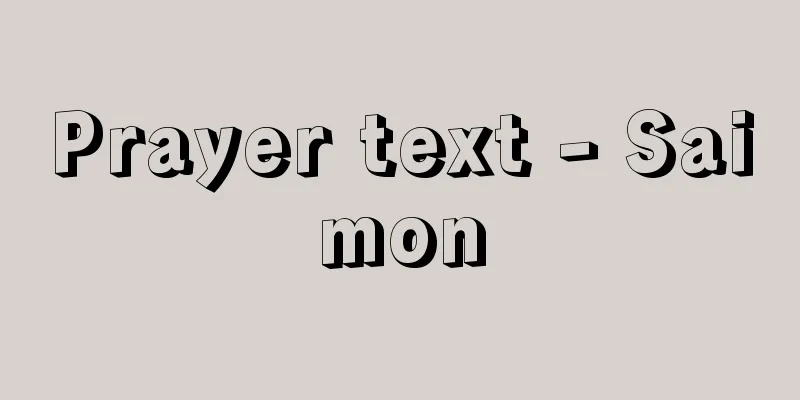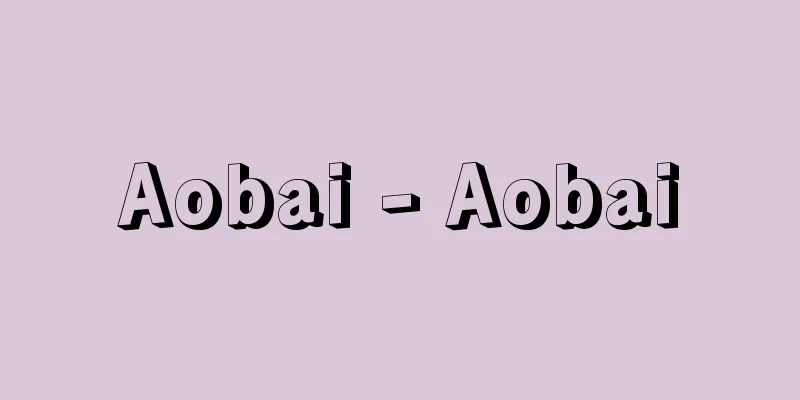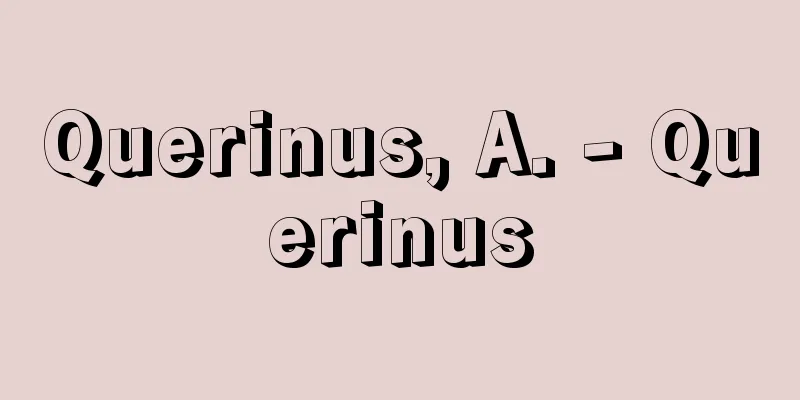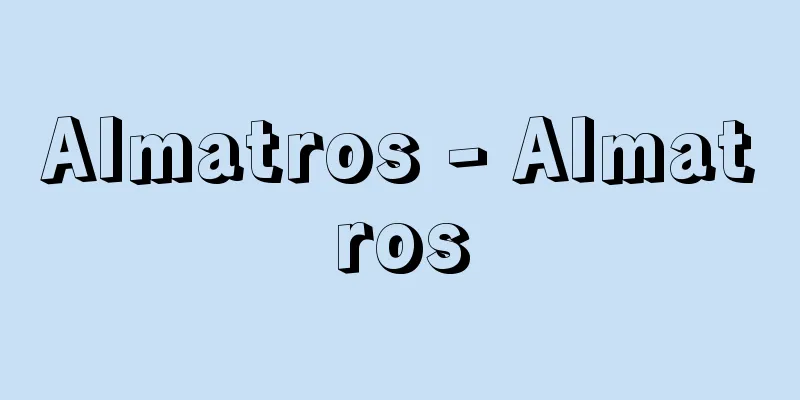Prayer text - Saimon

|
A written text recited during a divine festival. In Japan, those recited to the gods are generally called norito (prayer), but they were also called saimon (ritual text). From ancient times to the Middle Ages, there are examples of norito called saimon (ritual text) (Nakatomi saimon, Miyanome no matsuri saimon), examples of norito mixed with Chinese characters (tsuina saimon), and examples of Chinese-style rituals (Sekiten saimon, saimon for the Koshi ceremony, a festival of heaven and earth performed by the emperor). From the Middle Ages onwards, they spread among the general public as yamabushi saimon (yamabushi saimon), utazaimon (utazaimon), and sekkyo saimon (setsukyou saimon), written by onmyouji (onmyoji), shugenja (shrine priests), and miko (shrine maidens). In the early modern period, there were also cases where memorial texts were recited at Confucian funerals. The texts that the Emperor sent his envoys to make presentations to shrines, tombs, etc. were called senmyo (decrees), but in 1873 (Meiji 6), this was renamed gosaimon (ritual texts), a name that has remained to this day. [Mure Hitoshi] The contents of the prayers first ask for the god to descend, then state the purpose of the prayer to the god when he descends, and sometimes continue with a promise of what to offer to the god when he hears the prayer and the request is fulfilled. In a sense, this entrusts the judgement of the validity of one's prayer to the god, and is called a Tenpan prayer, which became one of the origins of Kishomon. Later, due to the unique and interesting melody of the prayers, they became independent of faith and were turned into songs, and in the Edo period, song prayers sung by "prayer narrators" to the accompaniment of shamisen and conch shells became very popular. [Chijiwa Toru] Song FestivalIn Japan, where Shinto and Buddhism are intertwined, as religious events have become secularized, saibon has been trending toward performing arts since the Heian period. The people who secularized saibon were mountain ascetics, and it became much more secularized in the Middle Ages, and in the early modern period it became entertainment-oriented uta saibon, and finally "uta saibon" came to be abbreviated to "saibon". It became completely performing arts during the Genroku period (1688-1704), and reached its peak during the Kyoho period (1716-1736). Yamabushi sangyo would wave shakujo (a shakujo staff) and recite with a conch shell, and some uta saibon also included the shamisen. There were forms of saibon such as "respectfully bowing again," "respectfully bowing," and "I purify and purify you... I respectfully say," which were followed for a long time. During the Genroku period, secular news was also adopted, and they were also called "colorful rites" or "double suicide rites," and a kind of "kudoki" tone emerged. "Yaoya Oshichi," "Osome Hisamatsu," "Osan Mohee," "Kosan Kingoro," "Ohatsu Tokubei," "Ochiyohanbei," "Onatsu Seijuro," and "Oshun Denbei" were called the Eight rites. The melody of uta-saibon originated from shomyo, a unique form of speech produced by vocalization in a white voice. Kadozuke was also performed, with the conch shell playing the chant "deroren deroren," so the song was also called "deroren saibon" or "kai saibon." Uta-saibon influenced Bon Odori songs, and was further combined with sekkyo joruri to become sekkyo saibon, which also became a form of entertainment in vaudeville halls. Furthermore, chobokure and ahodarakyou became ukarebushi, which eventually gave birth to Naniwabushi. [Kazuo Sekiyama] "Gorai Shigeru (ed.), Collection of Historical Materials on the Lives of the Common People in Japan, Volume 17, Folk Performing Arts (1972, Sanichi Shobo)" [References] | | |Source: Shogakukan Encyclopedia Nipponica About Encyclopedia Nipponica Information | Legend |
|
神祭りのときに奏上する文詞。わが国の神祇(じんぎ)に奏するものを一般に祝詞(のりと)と称するが、祭文とも称することがあった。祝詞文を祭文と称した例(中臣(なかとみ)祭文、宮咩奠(みやのめのまつり)祭文)、祝詞文と漢文とを混交した例(儺(ついな)祭の祭文)、中国風の祭祀(さいし)についての例(釈奠(せきてん)の祭文、天子が行う天地の祭である郊祀(こうし)の礼の祭文)などが古代から中世にかけてみえる。中世以降になると、陰陽師(おんみょうじ)、修験者(しゅげんじゃ)、巫女(みこ)などの手により、山伏祭文、歌祭文(うたざいもん)、説経祭文などとして民間に広まった。また近世には、儒葬による葬儀で、死者を弔う祭文をあげる例もあった。なお、天皇が神宮・神社・山陵等に勅使を遣わして奏上したものを宣命(せんみょう)と称したが、1873年(明治6)これを御祭文(ごさいもん)と改称して今日に至っている。 [牟禮 仁] 祭文の内容は、まず神の降臨を請い、次に降臨した神に願うべき趣旨を述べ、さらに神がその願いを聞き、事が成就(じょうじゅ)したときには何を奉納するか、などを約束する文言の続くこともある。これはいわば自己の祈願の当否の判断を神にゆだねたもので、これを天判(てんぱん)祭文とよび、起請文(きしょうもん)の一つの源流となった。のちに祭文は、独得の節のおもしろさから、信仰を離れて歌謡化し、江戸時代には「祭文語り」によって三味線や法螺貝(ほらがい)にあわせて歌われる歌祭文がもてはやされた。 [千々和到] 歌祭文神仏混淆(こんこう)のわが国では、宗教行事の俗化のなかで、祭文はすでに平安時代から芸能化の傾向があった。祭文俗化の担い手は、山伏修験の者たちで、中世にはかなり俗化が進み、近世に入って娯楽的な歌祭文となり、ついに「歌祭文」を「祭文」と略称するようになった。元禄(げんろく)期(1688~1704)には完全に芸能化して、享保(きょうほう)期(1716~36)に全盛時代を迎えた。山伏出立(いでた)ちの者が錫杖(しゃくじょう)を打ち振り、法螺貝を口にして語り、歌祭文では三味線を加えたものもあった。祭文には「謹請(きんじょう)再拝」「抑々敬白(そもそもうやまってもうす)」「祓(はら)ひ清んめ奉る……敬って申す」などの型があり、長く踏襲された。元禄時代には世俗のニュースも採用し、「色祭文」「心中(しんじゅう)祭文」ともよばれて一種の「くどき」の調子も生じた。『八百屋(やおや)お七』『お染久松』『おさん茂兵衛(もへえ)』『小三(こさん)金五郎』『お初徳兵衛』『お千代半兵衛』『お夏清十郎』『おしゅん伝兵衛』を八祭文といった。 歌祭文の節(ふし)回しは声明(しょうみょう)から出たもので、白声(しらごえ)という発声による独特の語物であった。門付(かどづけ)も行い、法螺貝で「デロレンデロレン」と合の手を入れたので、「でろれん祭文」「貝祭文」ともいわれた。歌祭文は盆踊唄(うた)に影響を与え、さらに説経浄瑠璃(じょうるり)と結合して説経祭文となり、寄席(よせ)演芸にもなった。また、ちょんがれ(ちょぼくれ)、阿呆陀羅経(あほだらきょう)から浮かれ節となり、やがて浪花節(なにわぶし)を生むに至った。 [関山和夫] 『五来重編『日本庶民生活史料集成 第17巻 民間芸能』(1972・三一書房)』 [参照項目] | | |出典 小学館 日本大百科全書(ニッポニカ)日本大百科全書(ニッポニカ)について 情報 | 凡例 |
Recommend
Yoshiwara sparrow
Kabuki dance. Nagauta. Original title: "Oshi...
white magic
…Originally, it was a type of magic practiced amo...
Air route
A route is a passageway with a certain width (pro...
Collective unconscious
A term in analytical psychology created by Jung. I...
Audebert, JP (English spelling) AudebertJP
...The period from 1780 to 1830 was the golden ag...
Kenreimon Gate
[1] One of the gates on the outer wall of the Heia...
Katsurayama Koreshige
...The Omori clan of the Northern House of the Fu...
Mustard shop - Mustard shop
…His pen names were Toyotei, Shukodo, and Tatsumi...
Necessary and sufficient condition
Suppose the proposition "If p, then q" ...
Indonesia Association - Indonesia Kyokai (English) Perhimpunan Indonesia
A group of Indonesian students who engaged in anti...
Gunnera macrophylla (English spelling) Gunneramacrophylla
… [Mitsuru Hotta]... *Some of the terminology tha...
Muscle belly - Kinpuku
The bulging part in the center of the muscle. tend...
Coccyx - Stiffness
This refers to fused caudal vertebrae. As the nam...
Udo Shrine
It is located in Udo, Nichinan City, Miyazaki Pre...
Ikenobo Ryusei School
…Ikenobo also went into a period of decline, but ...









